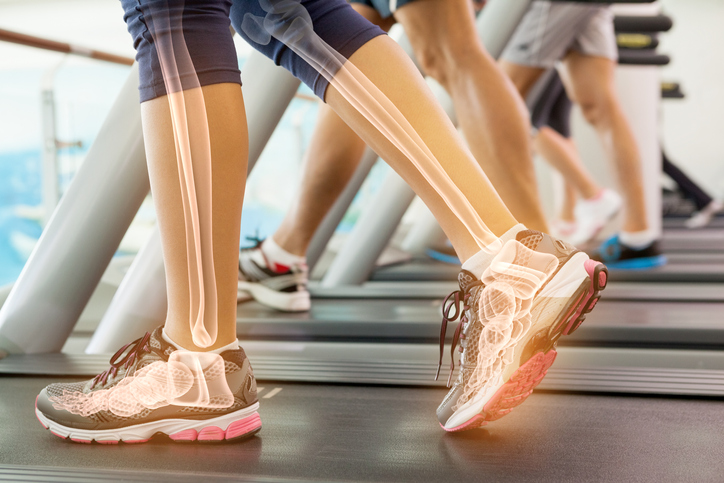
Digital composite of Highlighted ankle of woman on treadmill
John Hawk Insunrated – Keep Your Bones and Joints Healthy as you age to maintain mobility and independence. As we grow older, our bones and joints naturally lose strength and flexibility. This can lead to pain, stiffness, and even chronic conditions like arthritis. However, with proper care, we can slow down or prevent these effects. In this article, we will explore practical steps to keep your bones and joints strong and functional as you age.
Bone and joint health are crucial for maintaining an active and healthy lifestyle. Strong bones provide support for the body and protect vital organs. Joints allow for movement and enable us to perform daily activities. Without proper care, bones can become brittle, and joints can become stiff or inflamed. Maintaining their health reduces the risk of fractures, pain, and decreased mobility.
“Read about: Solo Healing Journey: Exploring Nature for Inner Peace”
Regular exercise is one of the most effective ways to maintain bone and joint health. Weight-bearing exercises, such as walking, jogging, or dancing, help strengthen bones by stimulating bone formation. These activities also improve joint flexibility and overall mobility. Strength training exercises, like lifting weights or using resistance bands, can enhance muscle support for your joints.
Stretching exercises, including yoga or Pilates, are also beneficial for improving flexibility and maintaining joint range of motion. These exercises help prevent stiffness and reduce the risk of injuries. Aim for at least 150 minutes of moderate-intensity exercise each week to keep your bones and joints healthy.
Nutrition plays a vital role in bone and joint health. To keep your bones strong, ensure you’re getting enough calcium and vitamin D. Calcium is essential for bone density, while vitamin D helps your body absorb calcium effectively. Dairy products like milk, yogurt, and cheese are excellent sources of calcium. Leafy greens, tofu, and fortified plant-based milks also provide good amounts of calcium.
Vitamin D can be found in foods like fatty fish, egg yolks, and fortified cereals. Sunlight exposure also helps your body produce vitamin D naturally. Omega-3 fatty acids, found in fish like salmon, sardines, and mackerel, have anti-inflammatory properties that can reduce joint pain and stiffness.
Magnesium, found in nuts, seeds, and whole grains, also supports bone health. A balanced diet that includes these nutrients helps prevent bone loss and maintains joint function.
Maintaining a healthy weight is crucial for protecting your joints. Extra weight puts additional pressure on your joints, particularly the knees, hips, and lower back. Over time, this can lead to joint pain and conditions like osteoarthritis. By managing your weight, you reduce the strain on your joints and lower your risk of developing joint-related issues.
Eating a balanced diet and staying active are key to achieving and maintaining a healthy weight. If you’re struggling to lose weight, consult a healthcare professional or nutritionist for personalized guidance.
“Read more: How Weight Lifting Improves Your Overall Health and Fitness”
Staying hydrated is essential for joint health. Water helps keep the cartilage in your joints lubricated, reducing friction and preventing damage. Dehydration can lead to stiffness, discomfort, and increased wear on your joints. Aim to drink at least eight glasses of water a day to keep your joints well-lubricated.
In addition to water, you can consume beverages like herbal tea or diluted fruit juices to stay hydrated. Avoid excessive alcohol or caffeine, as they can contribute to dehydration.
As you age, it’s important to use joint protection techniques to reduce wear and tear. For example, avoid repetitive movements or excessive stress on your joints. Use proper posture when sitting, standing, or lifting objects to prevent unnecessary strain. When performing tasks like lifting heavy items, use your legs instead of your back to minimize pressure on your joints.
Wearing supportive footwear can also make a difference. Choose shoes with good arch support to reduce the strain on your knees, hips, and lower back.
Regular medical check-ups are essential for monitoring bone and joint health. Your doctor may recommend bone density tests to assess your risk of osteoporosis, especially if you’re over 50 or have a family history of bone diseases. If you experience joint pain, stiffness, or swelling, seek medical attention promptly to prevent further damage.
In addition to regular check-ups, consider seeing a physical therapist if you have specific joint concerns. They can provide targeted exercises and stretches to improve your mobility and reduce pain.
In some cases, supplements may be recommended to support bone and joint health. Calcium and vitamin D supplements can help ensure you’re meeting your daily nutritional needs. If you have joint pain, glucosamine and chondroitin supplements are often used to support joint health and reduce inflammation. Before starting any supplements, consult with your doctor to determine if they’re right for you and to avoid potential interactions with other medications.
John Hawk Insunrated - Budget-conscious coffee lovers now have more options than ever, and this comprehensive home coffee makers review…
John Hawk Insunrated - Travel enthusiasts and professionals increasingly recognize that travel boosts creative thinking by exposing the mind to…
John Hawk Insunrated - creativity outside comfort zones often rises when people face novelty, moderate pressure, and meaningful constraints that…
John Hawk Insunrated - Many creators now adopt the anti perfection content workflow to publish quickly, learn fast, and grow…
John Hawk Insunrated - Many creators now adopt an anti perfectionist workflow guide to publish faster, learn from real feedback,…
John Hawk Insunrated - Artists, writers, and makers often underestimate how consistent creative practice daily reshapes their skills, confidence, and…